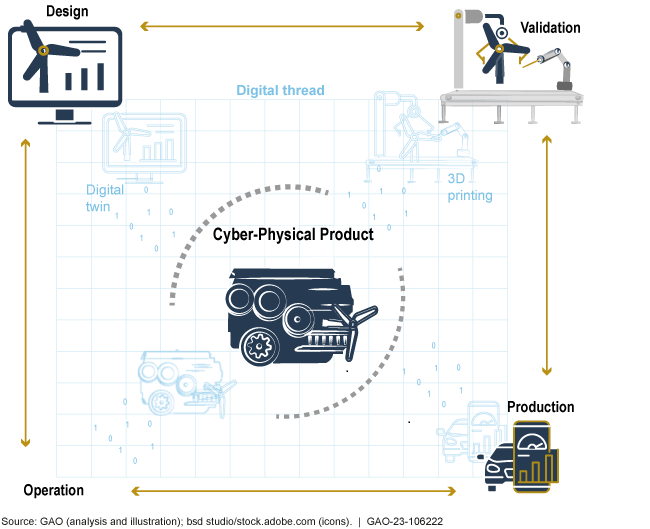Leading Practices: Iterative Cycles Enable Rapid Delivery of Complex, Innovative Products
Fast Facts
Agencies are increasingly investing in products that combine hardware and software—"cyber-physical systems"—to meet their mission needs. Traditional acquisition processes don't support speedy delivery of these systems.
Leading companies get these kinds of systems to market quickly using iterative design, testing, and feedback processes. For example, data from simulations and tests are recorded in a "digital thread"—a tool that product teams can access in real time to quickly and continually improve the product design.
Our report outlines cutting-edge practices that can inform agencies' ongoing efforts to improve acquisition performance.

Highlights
Why This Matters
Agencies are increasingly acquiring complex products, such as combined networks of hardware and software, which require new processes to design, produce, and deliver. GAO has found that to consistently deliver products with speed to users, acquisition programs for these networks—known as cyber-physical systems, such as aircraft and uncrewed vehicles—must adopt new approaches to evaluate performance and assess execution risks. Solutions, though, are unlikely to originate exclusively within government. Rather, identifying the practices that leading companies rely on to create cyber-physical products can provide crucial, cutting-edge information to acquisition leaders in government and, in turn, ultimately help frame changes to agencies’ acquisition processes.
For over 20 years, GAO has made numerous recommendations to the Departments of Defense (DOD) and Homeland Security (DHS) and the National Aeronautics and Space Administration (NASA) to implement best practices for their major acquisition programs that underpin successful product development within leading companies. Over this time, agency implementation of these practices saved taxpayers tens of billions of dollars.
Key Takeaways
Leading companies use iterative processes to design, validate, and deliver complex cyber-physical products with speed. Activities in these iterative cycles often overlap as the design undergoes continuous user engagement and testing. Knowledge about the product’s design is progressively refined and stored in a digital thread—a common source of information that helps stakeholders make decisions, like determining product requirements, throughout the product’s life.
As they proceed, product teams refine the design to achieve a minimum viable product (MVP)—one with the initial set of capabilities needed for customers to recognize value. They use modern manufacturing tools and processes to produce and deliver the product in time to meet their customers’ needs.
Leading Companies Progress through Iterative Cycles to Develop a Minimum Viable Product

Similar to Agile software development, the iterative structure leading companies employ when developing complex, cyber-physical products revolves around companies rapidly designing, validating, and delivering products. These cycles are:
- Design modeling and simulation: During design modeling and simulation, product teams feed technical data from fast, iterative design cycles into the digital thread. Stakeholders—including users, engineers, and manufacturers and suppliers—use this information to confirm that the team has captured the right requirements and is on track to meet them.
Digital Thread Captures Information throughout the Product Life Cycle

For example, one leading company establishes models based on high-quality data from physical engineering, and captures input from users and manufacturers to feed into the models. Another leading company collaborates with users to identify the one thing that will differentiate the product from others, which then functions as an indicator of product performance. The outcome of design modeling and simulation is a solution—in the form of an MVP—that can then be validated through testing.
- Validation: Leading companies validate the design using prototypes—including combinations of physical and entirely digital prototypes. This prototyping incorporates all hardware and software components to test the product’s integrated functionality in its operating environment. Sometimes companies do this by developing virtual representations of physical products—a process known as digital twinning—or by using 3D-printed parts to test performance.
For instance, one leading company uses a digital twin and virtual reality—immersion in a virtual environment using head-mounted displays—to enable users to step into a virtual vehicle and validate its design. Another leading company used a digital twin of an industrial motor drive to simulate its overload to the point of explosion. Compared with a physical test, which would have destroyed the prototype, developers could observe the specific point of explosion, locate defects, and fix them in the digital twin. - Production and Delivery: Leading companies develop the design to the point that it satisfies user requirements for a MVP. Product teams then stop designing hardware for the given MVP and prepare parts for production, recognizing that they can add functionality through software updates later. Companies use digital twinning to understand optimal factory design and manufacturing processes before the design enters production.
For example, one leading company uses digital twins to align parts assembly processes to ensure the robot handling the part can do so efficiently. The digital thread documents all the steps throughout production, from the design of the machinery and toolset, to the processes for manufacturing and assuring the product meets the company’s quality standards. Post-production user feedback informs further development of the next product.
How GAO Did This Study
Three congressional mandates provide for GAO to annually assess selected DOD, DHS, and NASA acquisition programs, projects, and activities. In order to respond effectively to these mandates, GAO conducted this work to understand (1) how leading companies structure their development of complex, cyber-physical products; and (2) the specific practices that enable this structure to properly function.
GAO identified 14 leading product development companies based on rankings in well-recognized lists; interviewed company representatives; reviewed supplementary documentation; and synthesized information to determine key product development structures and activities.
